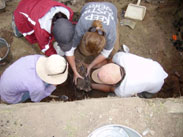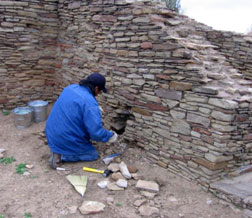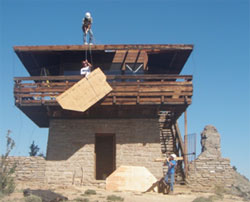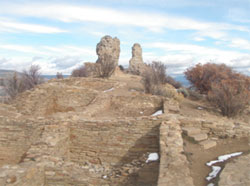Grant News
Chimney Rock
A Site "Saved"
Chimney Rock, located on the San Juan National Forest near Pagosa Springs, in southwestern Colorado, has been described as the “Ultimate Outlier.” It is considered the northeastern most Chacoan Outlier and was occupied by Ancestral Puebloans from A.D. 900 – 1125. The site features a Chacoan Great House. Multiple astronomical alignments have been identified within the Chimney Rock Archaeological Area.
The site was initially excavated in the 1920s; after these excavations it was left open to the elements. During the 1970s it was re-excavated and stabilized. Hundreds of years of exposure to the elements took their toll on the structures at Chimney Rock. In 2006 unusually heavy monsoon rains saturated soils and caused several walls to collapse; although emergency stabilization was completed to address the immediate concerns, additional work was identified as necessary to stabilize the site. In 2008 Chimney Rock was listed on Colorado Preservation’s list of endangered places.
In 2009 work began on an ambitious stabilization project. This project was primarily funded by multiple grants and donations totaling over $500,000 (Save America’s Treasures, Colorado State Historical Fund, Gates Family Foundation, Chimney Rock Interpretive Association, University of Colorado, and Tourism Cares for Tomorrow all provided funding). The project involved three main stages of work. The overall project required equalizing fill between adjoining rooms (differential fill causes water to migrate through walls causing them to weaken and fail) as well as repairs to the walls themselves. The first stage of the project involved removing fill from two unexcavated rooms; a University of Colorado team (under the direction of Dr. Stephen Lekson and Brenda Todd) undertook excavations. In the process of this work we uncovered new information regarding the construction, occupation, and abandonment of the site. Exciting finds included finding burned corn, wood roofing which was datable using dendrochronology, a living surface with pots sitting on top of a floor, and a grizzly bear jaw. Data from this phase of the project is still being analyzed. The next stage of the project involved architectural documentation of the great house and multiple other structures across the site. Woods Canyon Archaeological Consultants, Inc. undertook this work (under the direction of Jason Chuipka). Analyzing the documentation regarding previous work at the site, particularly as it indicated the prehistoric and historic construction history, was important. Photometric records of each wall, annotated with information regarding previous stabilization work and recommended repairs, were produced; these records will help provide a base line of conditions at the site as it was in 2009 to 2010 and helped identify priority repairs. The next stage of work was conducted by Petrographics beginning in 2010 (under the direction of Chris Zeller). This work involved repairing walls, improving drainage off the wall cap, adding draining at key areas within structures and contouring the fill in rooms to discourage drainage through walls. This work is largely complete although additional backfill of some rooms and fill contour will continue this summe
American Recovery and Reinvestment Act (ARRA) funds were also used for projects at Chimney Rock in 2009 and 2010. Preservation activities funded by ARRA included installing moisture monitors during stabilization activities. These monitors will help archaeologists evaluate the efficiency of past and current stabilization efforts and recognize structural concerns into the future. ARRA funds also helped improve facilities and develop additional interpretive signage. A major change at the site involved the removal of the Chimney Rock Fire Lookout Tower, which shared the mesa top with the prehistoric Great House. The tower was initially constructed in the 1940s, largely removed in the 70s, and reconstructed in the late 80s. Its location detracted from the unique archaeological setting of the world-class Ancestral Puebloan site, obstructing views of the rock pinnacles from the Great House and kiva, and blocking views of astronomical alignments that the prehistoric inhabitants incorporated into their layout of the site. Future visitors to the site will feel that they can reach out and touch the rock pinnacles, as prehistoric inhabitants of the site would have. In addition, crumbling masonry walls around the upper parking lot received a concrete cap to deflect water, and a non-functional restroom has been removed and replaced with a concrete patio area.
As a result of the work conducted at Chimney Rock in 2009 through 2010, the site was announced as “saved” at the Colorado Preservation, Inc., Saving Places Conference on February 3, 2010. This represents a major accomplishment for the San Juan National Forest which oversaw all work and the organizations which funded and performed this work. Although there will be ongoing routine maintenance needs to prevent the site from collapsing (as with any structure, prehistoric or new), the site is no longer in imminent danger of collapse. Visitors should now be able to enjoy Chimney Rock for generations. Chimney Rock is open for tours from May 15 through September 30; for more information on tours visit www.chimneyrockco.org.




